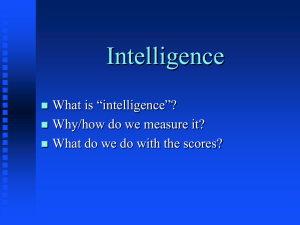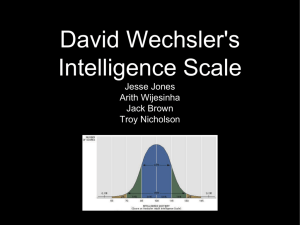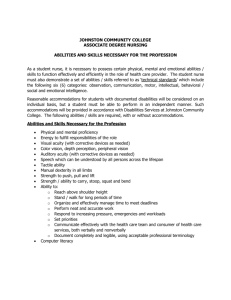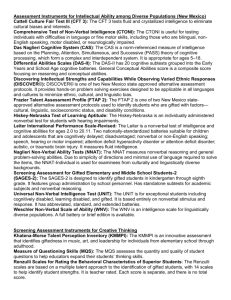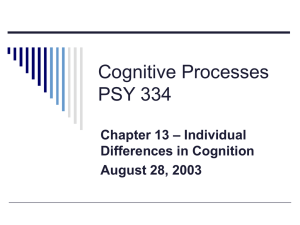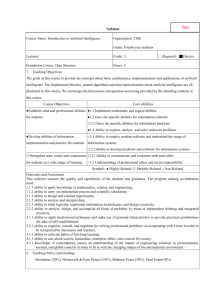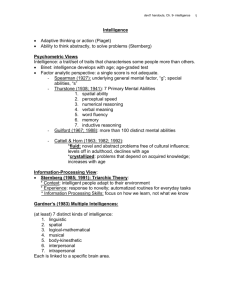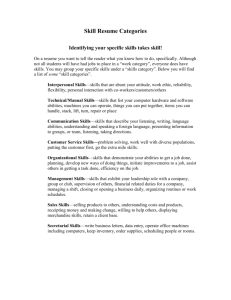Intelligence and Aging
advertisement
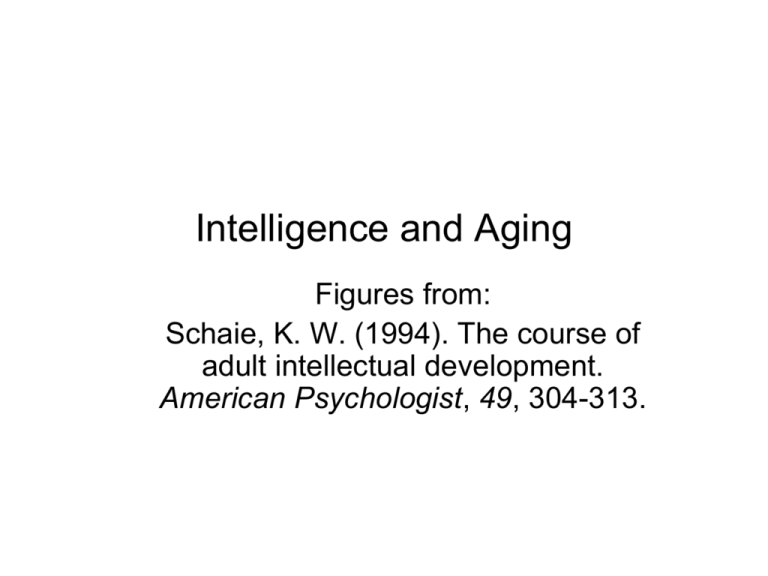
Intelligence and Aging Figures from: Schaie, K. W. (1994). The course of adult intellectual development. American Psychologist, 49, 304-313. Forms of intelligence Triarchic theory • Sternberg (1985) – Problem-solving (Analytic) Analytic • Logical, reasoning – Verbal (also called Creative) • Vocabulary, novel tasks – Social competence (Practical) • “Street smarts” Verbal Practical Psychometric approach • Factor analysis: Examine correlations between tests • Spearman (1904) 2 y.1 – “g” and “s” 4 0 • If high correlations -2 – “g” or general intelligence • If low correlations -4 -3 0 1 2 3 4 3 • Thurstone (1938) – Verbal meaning, word fluency, numerical ability, spatial ability, verbal memory, perceptual speed, and reasoning -1 x.1 – “s” or specific intelligences 2 1 y.2 – 7 independent “primary mental abilities” -2 0 -1 -2 -3 -3 -2 -1 0 x.2 1 2 3 Schaie (1994) Seattle Longitudinal Study • Core battery: Thurstone’s (1938) primary mental abilities – Verbal meaning – Space – Reasoning – Number – Word fluency • First, whether intelligence changes uniformly through adulthood or whether there were different life-course ability patterns. • Second, at what age reliably detectable age decrements in ability occurred and to determine the magnitude of that decrement. • Third, investigate patterns of generational (cohort) differences in intellectual abilities as well as their magnitude. • Fourth, stability of the factor structure of the psychometric abilities across the adult life course. • Fifth, what accounts for the vast individual differences in age-related change in adulthood. • And, whether intellectual decline with increasing age can be reversed by educational interventions. Schaie, K. W., Maitland, S. B., Willis, S. L., Intrieri, R. C. (1998). Longitudinal invariance of adult psychometric ability factor structures across 7 years. Psychology and Aging,13, http://geron.psu.edu/sls/researchers/measures.html Differences in Life-Course Ability Patterns Figure 2. Cross-Sectional Mean T Scores for Single Markers of the Primary Mental Abilities Figure 3. Longitudinal Estimates of Mean T Scores for Single Markers of the Primary Mental Abilities Figure 5. Cross-Sectional Mean Factor Scores for the Latent Ability Constructs Figure 6. Longitudinal Estimates of Mean Factor Scores for the Latent Ability Constructs Figure 7. Cohort Gradients for the Single Markers of the Primary Mental Abilities Flynn effect Schaie (1994) The variables identified to reduce the risk of cognitive decline in old age include the following: • • • • • • • The absence of cardiovascular and other chronic diseases. Living in favorable environmental circumstances as would be the case for those persons characterized by high SES. Substantial involvement in activities such as: reading, travel, attendance at cultural events, pursuit of continuing education activities, and participation in clubs and professional associations Individual's self-report of a flexible personality style at midlife as well as flexible performance on objective measures of motor–cognitive perseveration tasks Being married to a spouse with high cognitive status. The maintenance of high levels of perceptual processing speed into old age Rating one's self as being satisfied with one's life's accomplishment in midlife or early old age. Forms of intelligence • Cattell & Horn (1966) – Crystalized intelligence – Fluid intelligence • Raven’s progressive matrices Crystalized vs fluid intelligence Vocabulary test • Connect: Accident lace flint join bean field • Provide: Harmonize hurt annoy commit supply divide • Dwindle: Swindle diminish linger pander wheeze compare • Bombastic: Democratic bickering destructive pompous cautious anxious • Recumbent: Fugitive unwieldy reclining cumbersome repelling penitent • Glower: Extinguish disguise aerate shine gloat scowl IQ tests: Visual reasoning Stanford-Binet Test: IQ • Verbal reasoning – Vocabulary – Comprehension – Verbal relations • Abstract/visual reasoning – Pattern analysis – Copying – Paper folding and cutting • Quantitative reasoning – Number series – Equation-building • Short-term memory – Bead memory – Memory for sentences and digits – Memory for objects Training studies • Willis & Nesselroade (1990) • Cattell’s Culture Fair Test – Figure series – Figure classify – Matrices – Topology • http://www.alliqtests.com/tests/7/8/ Moderators of intellectual change • • • • Age-related changes Cohort differences Educational level Change in cognition – Perceptual (processing) speed – Working memory – Inhibition or inability to avoid interference • Social variables – – – – Occupations Socioeconomic status Exposure to stimulating environments Social engagement (vs lonliness) • Personality – Self-efficacy; positive beliefs or attitudes – Neuroticism and chronic psychological distress • Health and lifestyle – Cardiovascular disease, hypertension, sensory functioning • Relevancy and appropriateness of tasks Baltes & Lindenberger (1997) • Visual and auditory acuity related to fluid intelligence Willis et al. (Allaire & Marsiske, 2002) • Examine correlations of 7 primary mental abilities – Traditional tasks vs everyday tasks • Which primary abilities predict everyday performance? – Fluid intelligence (figural relations) Allaire & Marsiske, 2002
